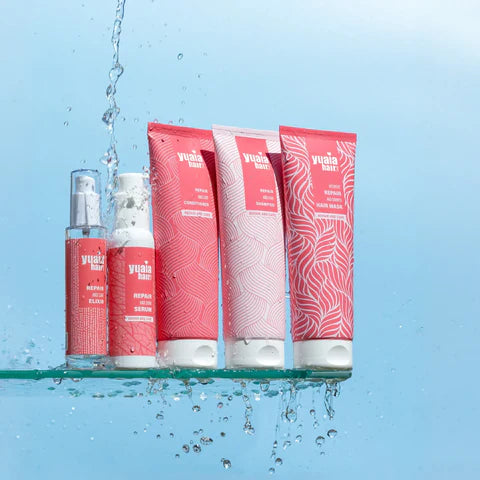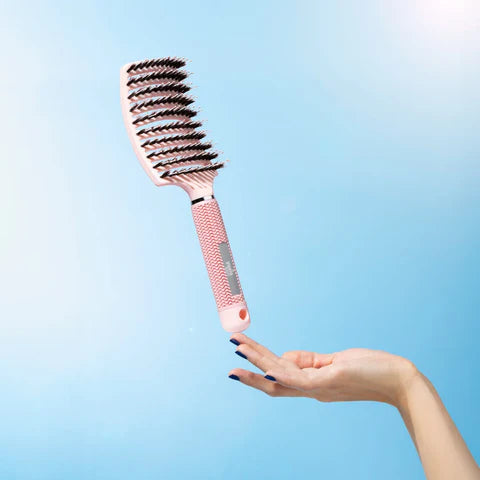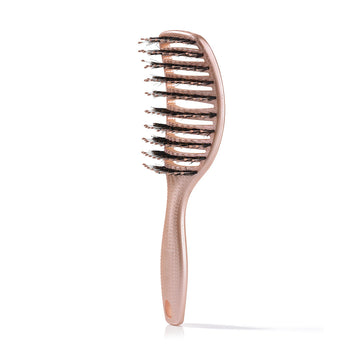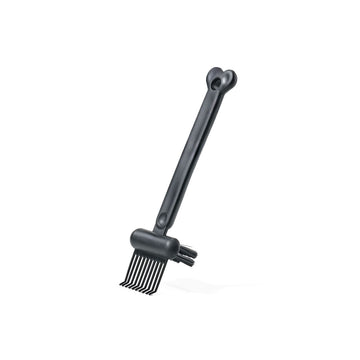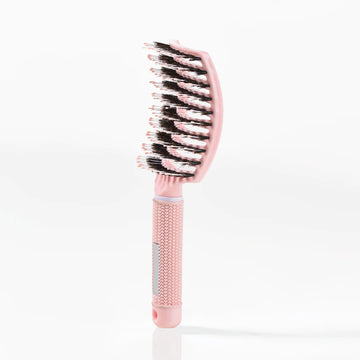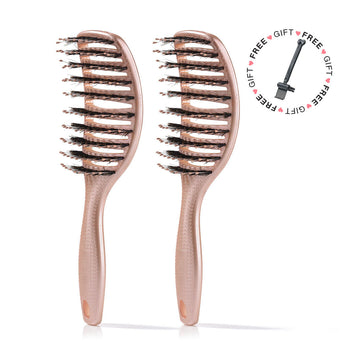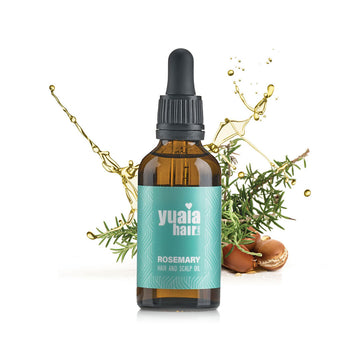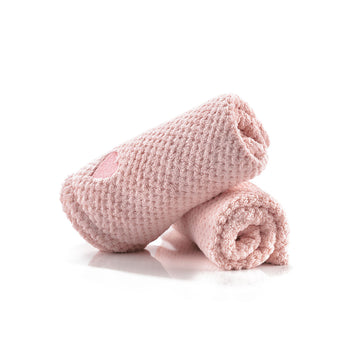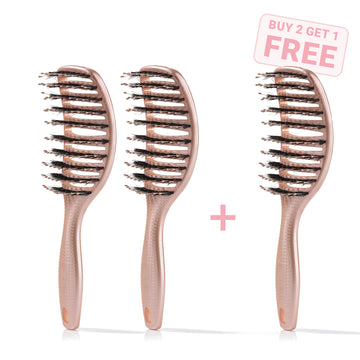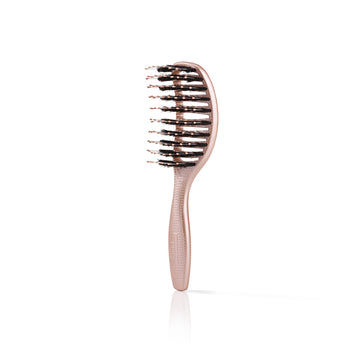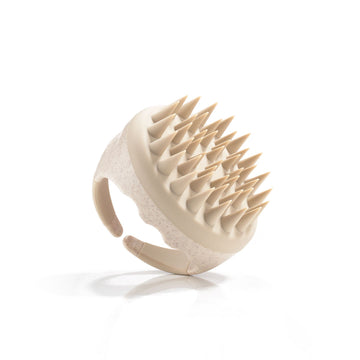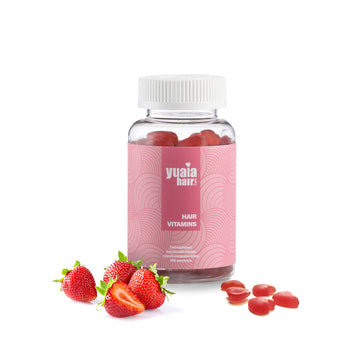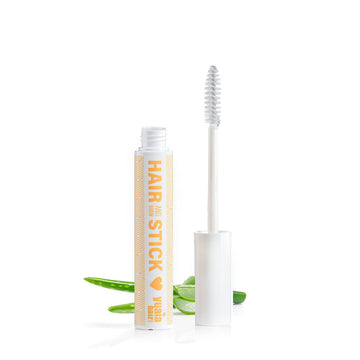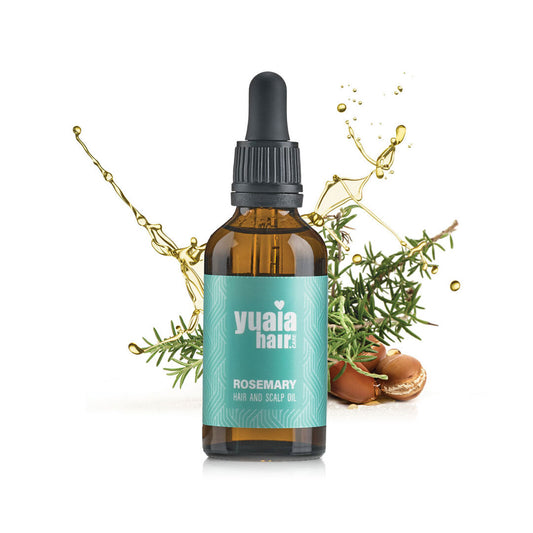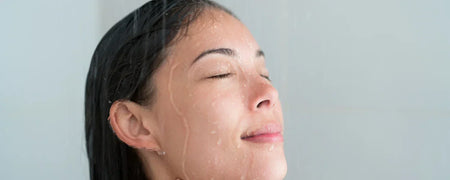
Benefits of using a hair rinse
Using a hair rinse regularly can bring multiple advantages and significantly enhance the overall quality of your haircare routine:
-
Eliminates product buildup that shampoos may leave behind, helping to prevent dullness and clogged hair follicles
-
Balances the scalp's pH, which is essential for maintaining a healthy barrier and reducing excess oil production or dryness
-
Enhances light reflection by smoothing the hair cuticle, resulting in improved shine, softness, and manageability
-
Minimizes scalp irritation, soothes itchiness, and helps reduce flaking or dandruff caused by imbalance or residue
-
Can assist with detangling and reduce static, especially for those with fine or frizz-prone hair
-
Revives limp or lifeless hair, giving it a fresher, more voluminous appearance between full wash days
These effects can lead to noticeably healthier-looking hair, improved scalp comfort, and a refreshed scalp environment that supports long-term hair wellness.
Step-by-step: How to use a hair rinse
-
Shampoo your hair
Begin by washing your hair thoroughly with shampoo to cleanse the scalp and strands. -
Apply the hair rinse
After rinsing out the shampoo, slowly pour the hair rinse over your scalp and the lengths of your hair. Make sure to distribute it evenly so all areas are saturated. -
Massage the scalp
Gently massage the liquid into your scalp to stimulate blood circulation and help the rinse penetrate more deeply into the roots. -
Let it sit
Allow the rinse to sit for 2 to 15 minutes, depending on the product and your hair’s needs. This gives the active ingredients time to clarify, soothe, strengthen, or condition. -
Rinse out
Rinse your hair thoroughly with lukewarm water to remove any residue without stripping away the beneficial properties. -
Condition (optional)
If needed, follow up with conditioner—particularly if your hair is dry or coarse. Some rinses can also function as standalone treatments. -
Adjust usage over time
Refer to the product’s recommended usage and observe how your hair responds, adjusting frequency as needed.
Apple cider vinegar hair rinse
Apple cider vinegar (ACV) is mildly acidic and helps balance the scalp’s pH while sealing the hair cuticle. This can reduce frizz, enhance shine, and minimize breakage, making it a great option for dull, tangled, or hard-to-manage hair.
Its natural antimicrobial and antifungal properties help soothe irritation and reduce scalp buildup, making it beneficial for those with dandruff, excess oil, or frequent product use.
Regular use can improve hair manageability, clarify the scalp, and support a healthier scalp environment overall.
How to make it:
-
Mix 1 part raw, unfiltered apple cider vinegar with 4–5 parts water.
-
(Optional) Add a few drops of lavender or tea tree essential oil.
-
Pour the mixture into a clean container or spray bottle.
-
Shake well before each use.
-
Apply evenly to scalp and hair after shampooing.
Green tea hair rinse
Green tea is rich in antioxidants and mildly astringent, making it ideal for oily scalps or light dandruff. Its compounds, like catechins, help reduce free radical damage while gently cleansing the scalp.
Caffeine and polyphenols found in green tea may also help stimulate follicles and soothe inflammation, improving scalp conditions over time. These properties make it suitable for those with mild hair thinning or sensitivity.
It’s a gentle option for color-treated or delicate hair and can support shine, reduced shedding, and scalp comfort with regular use.
How to make it:
-
Bring approximately 2 cups of water to a boil.
-
Add 1–2 green tea bags to the hot water.
-
Let the tea steep for 5–10 minutes.
-
Remove the tea bags and allow the tea to cool completely.
-
(Optional) Add 1–2 drops of peppermint or chamomile essential oil.
-
Pour the cooled tea into a clean container or spray bottle.
-
Apply evenly to scalp and hair after shampooing.
Rosemary hair rinse
Rosemary is known for stimulating blood flow to the scalp, which may support hair growth by nourishing the hair follicles and encouraging stronger strands. This herb has long been used in herbal medicine and haircare traditions to combat thinning hair and improve overall scalp health. Its invigorating scent and therapeutic oils can also provide a sensory benefit during your haircare routine.
The antimicrobial and anti-inflammatory properties of rosemary help reduce flakiness and soothe scalp irritation, making it a great option for those experiencing dandruff, itchiness, or buildup. Additionally, rosemary is rich in antioxidants that may protect the scalp from environmental stressors and oxidative damage.
How to make it:
-
Bring 2 cups of water to a boil in a small pot.
-
Add a handful of fresh rosemary or 2 tablespoons of dried rosemary to the water.
-
Boil the rosemary in the water for 15–20 minutes.
-
Remove the pot from heat and allow the mixture to steep for an additional 10 minutes.
-
Strain out the rosemary and let the liquid cool completely.
-
(Optional) Add 3–4 drops of rosemary essential oil for stronger scalp-stimulating effects.
-
Pour the cooled infusion into a clean bottle or jar.
-
After shampooing, pour the rinse slowly over your scalp and hair.
-
Let it sit for 5–10 minutes before rinsing thoroughly with water.
Rice water hair rinse
Rice water has been used in traditional Japanese and Chinese haircare for centuries, particularly among court women and villagers known for their long, strong, and shiny hair. This simple yet effective remedy contains amino acids and inositol—a carbohydrate compound believed to repair damaged hair and protect it from further breakage. These nutrients are thought to penetrate the hair shaft, helping to improve elasticity, reduce split ends, and boost shine. Many users also report a noticeable decrease in hair fall and breakage after consistent use, as well as increased softness and manageability.
In addition to its strengthening benefits, rice water may help soothe the scalp, reduce irritation, and promote a balanced scalp environment. It is particularly popular among those looking to grow their hair longer or restore resilience to chemically treated or heat-styled hair.
How to make it (step-by-step):
-
Measure out 1/2 cup of uncooked white or brown rice.
-
Rinse the rice thoroughly to remove dirt and surface starch.
-
Place the rinsed rice in a bowl with 2–3 cups of water.
-
Let it soak for 12–24 hours at room temperature. For a fermented version, allow it to sit for up to 48 hours until it smells slightly sour.
-
Strain the rice water into a clean container.
-
(Optional) Add a drop or two of essential oil such as lavender to improve scent.
-
Use it after shampooing by pouring it over the hair and scalp, massaging gently, and leaving it on for 10–20 minutes before rinsing thoroughly.
Which rinse should you use?
Each rinse offers unique benefits that cater to different hair and scalp needs:
-
Apple cider vinegar: Best suited for oily hair and those struggling with buildup, ACV helps restore scalp pH, eliminate residue, and reduce flakiness, leaving the scalp balanced and the hair smoother.
-
Green tea: Ideal for calming the scalp and reducing mild inflammation, green tea offers antioxidant protection, supports follicle health, and can gently cleanse sensitive or oily skin without stripping moisture.
-
Rosemary: A great option for anyone dealing with thinning or dull hair, rosemary encourages blood circulation to the scalp, supports hair growth, and offers antimicrobial benefits to clarify and refresh.
-
Rice water: Especially beneficial for those with dry, brittle, or damaged hair, rice water delivers amino acids and nutrients that enhance hair strength, improve elasticity, and reduce breakage over time.
You can alternate rinses throughout the week or month based on what your hair needs most at a given time. For example, apple cider vinegar can be used once weekly to deeply cleanse and balance oil production. Green tea may be used mid-week to soothe and refresh the scalp. Rosemary can be introduced every few days to support growth and stimulate the roots, while rice water might be applied once every week or two to reinforce strength and softness. With this variety, you can tailor your rinse routine for optimal, balanced results.
Tips and precautions
-
Always patch test before using any rinse, especially if you have a sensitive scalp or are prone to allergic reactions. Apply a small amount of the mixture to your inner arm or behind your ear and wait 24 hours to ensure no irritation occurs.
-
Avoid overuse, particularly with more acidic or protein-rich rinses, as excessive application can lead to dryness, imbalance, or even buildup over time. Tailor your routine based on your hair type and needs.
-
Proper dilution and rinse-out are important to ensuring both safety and effectiveness. Concentrated solutions can damage hair or irritate the scalp, while insufficient rinsing may leave residue.
-
Following up with conditioner may be helpful, especially for drier hair types, as it can lock in moisture and add softness. If using a rinse that may leave the hair feeling tight or squeaky, a light conditioner can restore balance without counteracting the rinse’s benefits.
-
Store any homemade rinses in a clean, airtight container and use within a few days to prevent spoilage or bacterial growth. Always discard if the scent or appearance changes.
Embrace the benefits of natural hair rinses for a healthier routine
Natural hair rinses are a simple yet effective way to promote healthier, shinier, and more balanced hair. They help address concerns like buildup, dryness, oiliness, and sensitivity—without relying on synthetic ingredients. By incorporating a rinse into your routine, you support your scalp’s natural balance while enhancing your hair’s texture over time.
These treatments also serve as a calming self-care ritual that can easily fit into your schedule. Their flexibility allows you to tailor your approach with ingredients that match your scalp’s needs across the week or season.
Whether you want to detoxify the scalp, soothe irritation, or simply refresh between washes, there’s a natural rinse to suit your goals. Begin with one type, observe the effects, and gradually develop a rhythm that works for you. With consistent use, you may notice smoother strands and a scalp that feels refreshed and supported.
Frequently Asked Questions
How often should I use a hair rinse?
Most people benefit from using a hair rinse 1–2 times per week, but frequency can be adjusted based on your hair type, scalp condition, and the specific rinse you choose. For example, apple cider vinegar rinses are often used weekly, while gentler rinses like green tea can be used more frequently.
Can I use a hair rinse instead of conditioner?
Some hair rinses, such as rice water or green tea, can provide conditioning benefits and may be used alone for certain hair types. However, if your hair is very dry or coarse, you may still want to follow up with a conditioner for added moisture and softness.
Are hair rinses safe for color-treated hair?
Most natural hair rinses are safe for color-treated hair, especially when properly diluted. Green tea and rice water are particularly gentle. However, always patch test and avoid overly acidic rinses if you have concerns about color fading.
Do I need to rinse out a hair rinse, or can I leave it in?
Most hair rinses should be rinsed out after allowing them to sit for a few minutes. Leaving some rinses in, especially those with acidic or protein-rich ingredients, may cause dryness or buildup. Always follow the instructions for your chosen rinse.
Can I mix different ingredients to create a custom hair rinse?
Yes, you can combine ingredients like herbs, teas, and essential oils to tailor a hair rinse to your needs. Just ensure all components are safe for your scalp and hair, and always dilute essential oils and acidic ingredients properly.
 2-4 day UK delivery
2-4 day UK delivery
 25.000+ satisfied customers
25.000+ satisfied customers
 Satisfaction Guarantee
Satisfaction Guarantee



